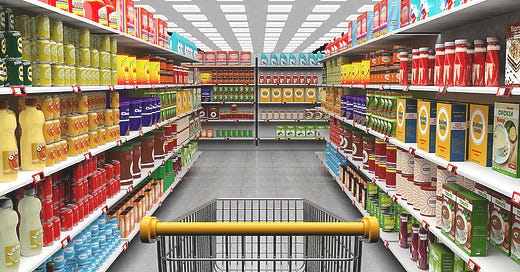Dear Dad,
What is food? Seriously. Define it. By clearly determining your definition of food you will make better eating choices down the road; because otherwise, some marketing expert will define food for you.
Standing in our kitchen as a ten year old I was making lunch. You and Mom were out of town and us kids were being watched by our Grandmother and Aunt. I opened the freezer, pulled out a frozen personal pan pizza, and began to open the box.
Your Sister watched from the kitchen table and encouraged, “Why don’t you make your own food.”
I looked up and rolled my eyes. Then, I retrieved two slices of bread from the pantry, peanut butter, and marshmallow fluff. I don’t think a PB & fluff sandwich was what your farming sister had in mind! The disconnect was that we had two totally different definitions of the word FOOD.
So what is your definition of food?
I bet your first inclined to give an answer with minimal thought, something along the lines of “food is what we eat.” I disagree and challenge you to push further. There are substances that we “eat” that are certainly not food. Some medications are technically eaten, but clearly not food. Ok. So our food definition should probably incorporate a standard of nutritional value versus solely products of science. But, what about a combination of both?
Is it food to combine enriched flour, sugar, soybean oil, palm oil, corn syrup, dextrose, high fructose corn syrup, & bleached wheat flour? Pop-Tart’s think so.
What about whole grain wheat, sugar, corn syrup, and salt? To be fair, this is the “Breakfast of Champions”—Wheaties.
It’s quite likely that before reading this letter you have never questioned whether the products that you eat for breakfast, lunch, dinner, and snacks are actually food—just as the creators of the above products planned. That’s because to many of us food is whatever is packaged and can be bought at a supermarket. Ninety percent (90%!) of the products found on grocery store shelves were nonexistent 100 years ago. Do you remember any Veggie Straw or Chips Ahoy plants on your family’s farm?
Possibly, the pathway from “farm to table” is important to incorporate into our definition of food. In fact, at the most basic level of nutrition everything that makes up our “food,” good or bad, is grown and harvested. We either eat animals that have already eaten the plants, we eat processed versions of the plants, or we eat the plants directly. So it’s instructive to consider what happens to food as it travels from the ground to our plate.
The truth is that a lot can happen as food travels down the supply chain. Remember from last week:
“Most of the things that we eat comes from large corporate entities shipping products all over the world while raking in billions of dollars…It’s undeniable that our health problems have tracked the development of the industrial food system [and]…the food-like-substances that make it to our tables are many times unrecognizable from the crop it once was.”
Somewhere along the chain of production the harvested food that we started with can morph into merely a “food product.” This is done to preserve shelf life, add colors, tastes and textures, and to ensure the product remains stable while sitting on the supermarket shelves. Such processing diminishes the nutritional quality of the original food, but fear not— enter person in a lab coat. Sugar, salt, and fat are all flavor enhancers that can revive a stale product into something irresistible. Chemical dies add bright eye catching colors and artificial emulsifiers are used to maintain smooth creamy textures. I believe that there is a line, that once crossed over, our “food” just becomes “food products.” It’s time to find the line.
Note the differences between a tub of Jiff Peanut Butter (Ingredients: roasted peanuts, sugar, molasses, fully hydrogenated vegetable oils [rapeseed and soybean], mono-glycerides, di-glycerides, salt) versus a fully Natural Peanut Butter (ingredients: dry roasted peanuts)…Yikes, quite a difference even though both items have about the same number of calories per serving! Sadly, many consumers who have not thought to define what actually makes a substance food will continually grab the Jiff, Peter Pan, or Skippy’s without much thought because the smooth and creamy texture remains day after day, whereas the natural option requires stirring because the blended peanuts naturally separate from their oil. One of these options is also much easier to overeat, making the similar calories per serving stat irrelevant. You guessed it, the artificially smooth and creamy peanut butter is devoured in less servings on average. Another food manufacturing trap.
This week as you evaluate your eating options and hunt the line that distinguishes “food” from merely “food products,” pause and consider: Will this provide nourishment? How did this product get from the ground to my plate? And, what ingredients have been stripped out or snuck in along the way? Read ingredient labels on any packaged item that you eat and ask the question: “Why are you in there?”
When it comes to packaged food products, be cynical.
With Love,
JSR




